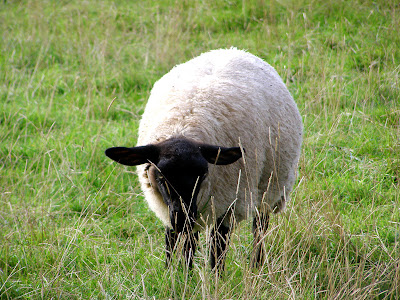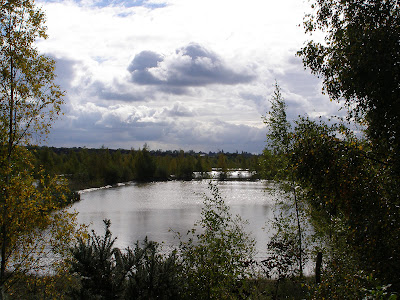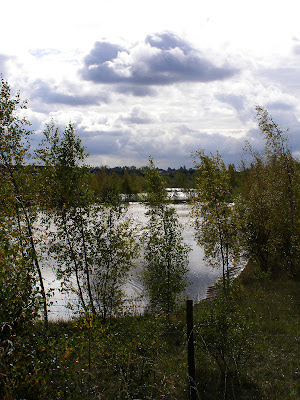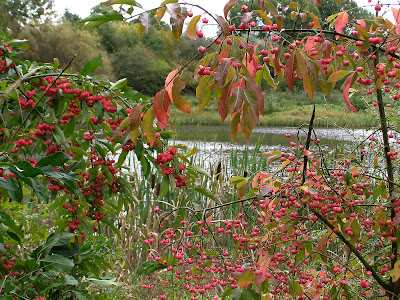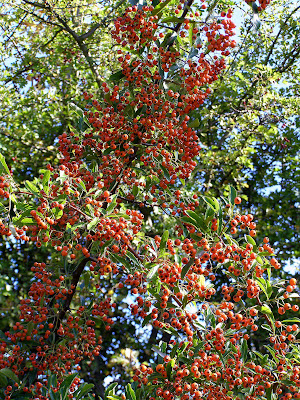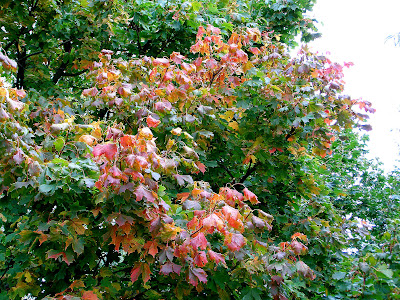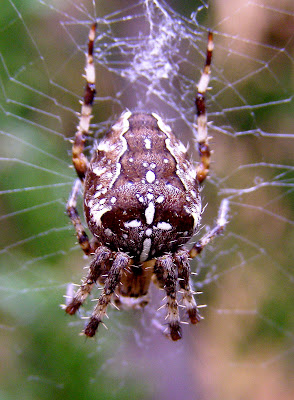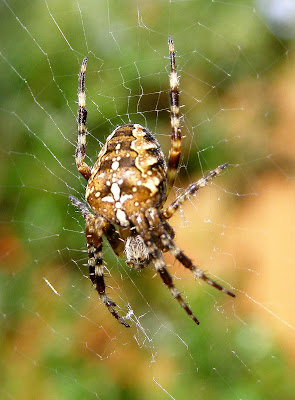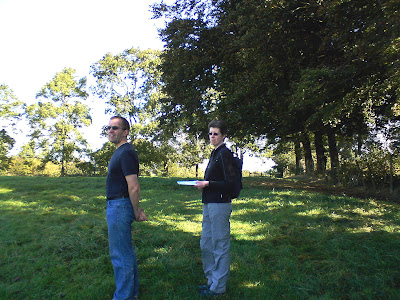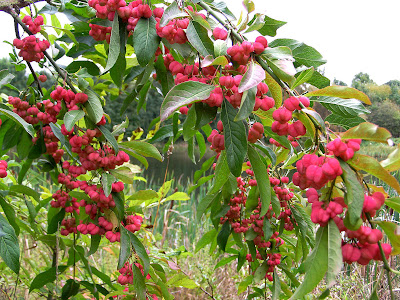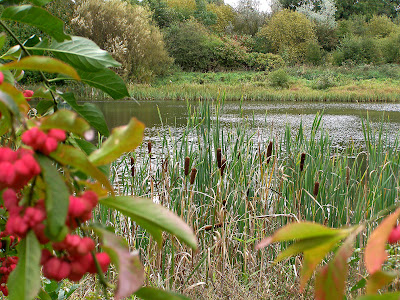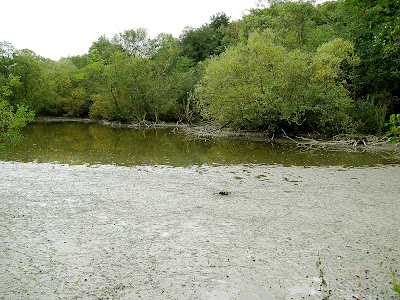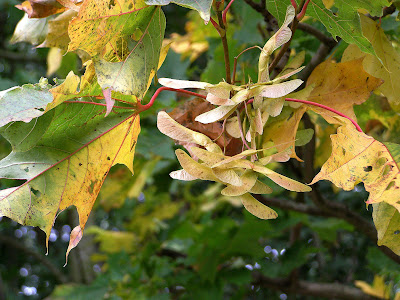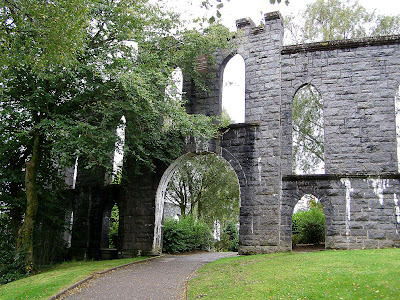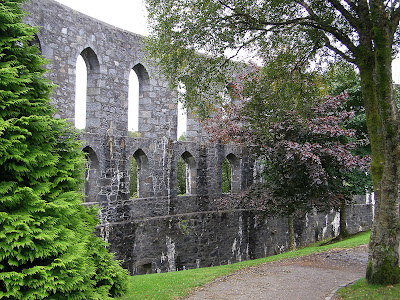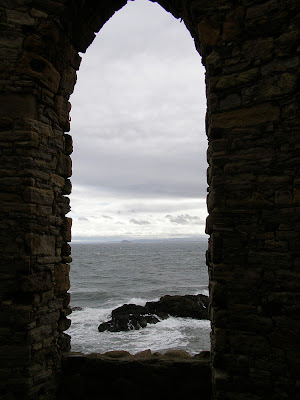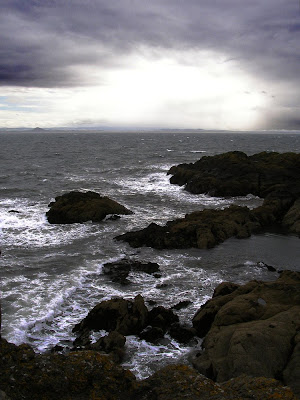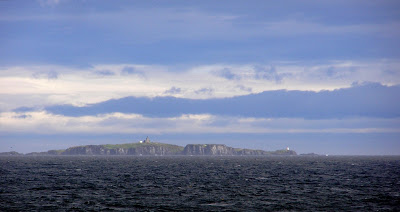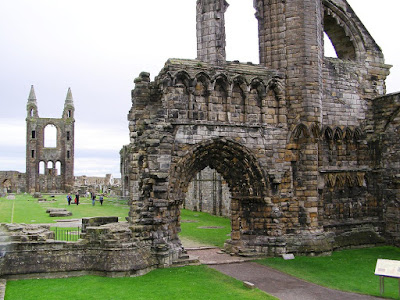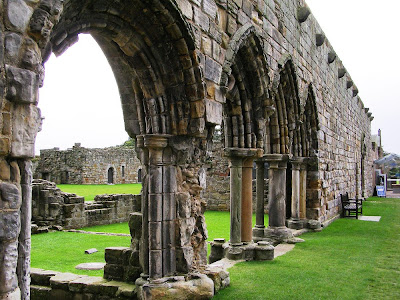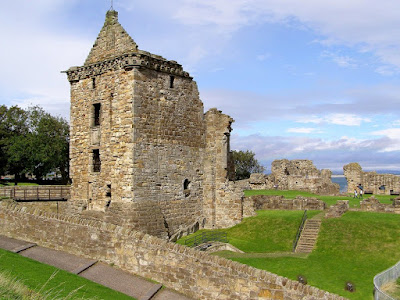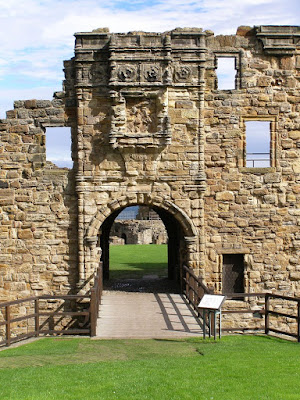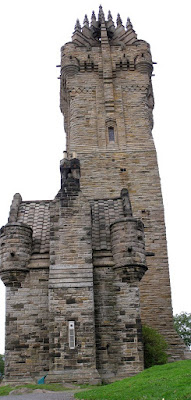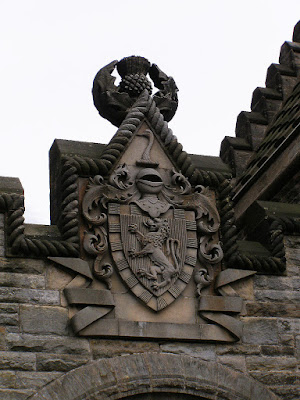Sheep, it is said 'May Safely Graze' according to Johann Sebastian Bach. This morning saw proof of this as Malcolm and I enjoyed a sunny walk around Mapperley reservoir.
Our walk around the reservoir today, turned out to be warm and wonderful - particularly as we managed to see two birds of note. Firstly was a fleeting glimpse of a Kingfisher as it flew low and fast across the water. Secondly and quite a surprise, was a Peregrine Falcon (the same one we saw the other day?). It caught our attention as it chased a Jay into a tree. The Jay had an extremely lucky escape as it flew at top speed into the branches squawking and squealing as it went. The Peregrine then turned it's attentions to an unsuspecting coot swimming across the reservoir. The coot obviously didn't see the approaching falcon as it dived, with breathtaking speed towards it. At the very last moment, the coot suddenly became aware of it's imminent death and dived beneath the water to escape. What a lucky bird!
Returning home, we walked past the group of six man-made ponds near our estate which together make up slurry settlement pits. Sounds nasty, but the idea is a good one. Waste water and slurry from the farms around the area, is pumped into the top two ponds and is allowed to settle as it fills them.
As they fill, the first two ponds empty into the next two at a slightly lower level. Again the 'solids' remaining in the water are allowed to settle out before the water flows on into the last two.
Water fills the last, lowest two ponds and is allowed to settle some more becoming beautifully clear by the time it reaches the end of the system. At this point, the water is pumped back into the Nutbrook stream system. A brilliant system which works very well with the minimum of fuss. You just don't want to be around when the pits have to be dredged to clear them out!
Slurry never looked so good!
Welcome to my blog. Don't expect anything too high-tech or flashy, this is simply a 'diary' to share some of my photos, thoughts and observations - with a particular bias towards the natural world and the countryside around my home.
Wednesday 30 September 2009
Tuesday 29 September 2009
Season of Mists..
With the hedgerows full to overflowing with the lusciousness of Autumn's harvest, it almost makes one wax lyrical. No-one put it better than John Keats....
The birds which depend upon this bounty to get them through the hard times of winter, should be well supplied this year.
Season of mists and mellow fruitfulness,
Close bosom-friend of the maturing sun;
Conspiring with him how to load and bless
With fruit the vines that round the thatch-eves run;
To bend with apples the moss'd cottage-trees,
And fill all fruit with ripeness to the core;
To swell the gourd, and plump the hazel shells
With a sweet kernel; to set budding more,
And still more, later flowers for the bees,
Until they think warm days will never cease,
For Summer has o'er-brimm'd their clammy cells.
Only part one of the poem 'To Autumn' shown here.
Monday 28 September 2009
Yew
A walk up to Shipley Hill this morning affording fine views towards the town. The Autumn colours are getting better by the day as you can see.
The Maples and Sycamores look almost as if they are on fire as the topmost leaves turn bright vermilion before tumbling to the ground.
Among the trees in the gardens of the old hall are some nice Yews (Taxus baccata). These elegant conifers are smothered in bright red 'berries'.
In fact, these 'berries' are not berries at all. They are actually modified cones - as found on other conifers. The mature cones of others are usually brittle, dry, brown in colour and contain many seeds. Yew cones by contrast, are fleshy, red and contain one seed. The fleshy, red part is, in fact a modified scale called an aril.
Yews are famous for being poisonous. Most people think the red 'berries' are poisonous but this is not strictly true. Only the seed inside is poisonous, the fleshy bit is not. Having said that, the Yew leaves are also poisonous.
Yews are also known to be extremely long-lived. Tree trunks of 12ft in diameter are not unknown and it would take 2000 years to reach this size. Accurate dating is difficult, if not impossible as the trunks tend to become hollow with age making tree-ring counting impossible. Reports of trees of between 5000 and 9500 years have been made, but even at 2000 years, the Yew remains the longest lived European tree. This longevity is the reason Yews are often planted in graveyards - to symbolise 'eternal life'.
The Maples and Sycamores look almost as if they are on fire as the topmost leaves turn bright vermilion before tumbling to the ground.
Among the trees in the gardens of the old hall are some nice Yews (Taxus baccata). These elegant conifers are smothered in bright red 'berries'.
In fact, these 'berries' are not berries at all. They are actually modified cones - as found on other conifers. The mature cones of others are usually brittle, dry, brown in colour and contain many seeds. Yew cones by contrast, are fleshy, red and contain one seed. The fleshy, red part is, in fact a modified scale called an aril.
Yews are famous for being poisonous. Most people think the red 'berries' are poisonous but this is not strictly true. Only the seed inside is poisonous, the fleshy bit is not. Having said that, the Yew leaves are also poisonous.
Yews are also known to be extremely long-lived. Tree trunks of 12ft in diameter are not unknown and it would take 2000 years to reach this size. Accurate dating is difficult, if not impossible as the trunks tend to become hollow with age making tree-ring counting impossible. Reports of trees of between 5000 and 9500 years have been made, but even at 2000 years, the Yew remains the longest lived European tree. This longevity is the reason Yews are often planted in graveyards - to symbolise 'eternal life'.
Saturday 26 September 2009
Old and New.
Continuing in the Autumnal vein, here are some more pictures from around our environs displaying the rich colours to be seen at the moment. Firstly a young Sycamore tree - the Maples always give good value in their Autumn dress.
I spoke of 'our environs' at the start. Lately however, it seems as though the closest part of this, namely our garden, has been usurped and claimed by another. There is a 'new kid on the block' keen to stamp his authority on what he obviously sees as his territory. When the usurper is as cute and playful as this little interloper, who can object?
Meet Oscar, our next-door neighbour's new kitten. Still too fast on his feet and too shy of the camera lens for me to get a sharp picture, but here's the best result so far.
When seen against a bright, blue sky they colours seem to leap out of the picture at you.
Some of the best leaves have a red hue, but the yellow ones are every bit as cheerful, even at this - some would say - more sombre time of year.I spoke of 'our environs' at the start. Lately however, it seems as though the closest part of this, namely our garden, has been usurped and claimed by another. There is a 'new kid on the block' keen to stamp his authority on what he obviously sees as his territory. When the usurper is as cute and playful as this little interloper, who can object?
Meet Oscar, our next-door neighbour's new kitten. Still too fast on his feet and too shy of the camera lens for me to get a sharp picture, but here's the best result so far.
Friday 25 September 2009
Yikes!
You know Autumn has arrived when everywhere is covered by spider's webs and you can't even leave the house without getting tangled up in the gossamer strands which have been spun across your front door. Now, anyone will tell you that I am afraid of these eight-legged little horrors, but here goes...
The Garden spider (Araneus diadematus) is among the most common species in Britain and at this time of year they seem to be particularly prevalent.
One of the group known as Orb-Web Spiders, they spin fantastic webs of classic shape and form with radiating 'spokes' and a spiral of silk holding it all together. The silk is spun and woven into place with the aid of the third pair of limbs. These limbs are of little use to the spider on the ground but are invaluable for getting about on the web without becoming entangled.
Webs are spun mostly by the larger females which then sit, head down, waiting for a stray insect to stumble into it.
These spiders are said to eat their webs (including anything caught in it) each night before spinning a fresh one in the morning.
As with many spider species, the smaller males have to be very wary when courting the females, so as not to end up an appetiser on her menu. This spider is mature from summer to autumn and is usually at its largest in late Autumn when it is at its oldest and often full of eggs. After laying their eggs the females die and only the eggs and the spiders that hatched in spring that year will over winter.
Charming little blighters aren't they?
The Garden spider (Araneus diadematus) is among the most common species in Britain and at this time of year they seem to be particularly prevalent.
One of the group known as Orb-Web Spiders, they spin fantastic webs of classic shape and form with radiating 'spokes' and a spiral of silk holding it all together. The silk is spun and woven into place with the aid of the third pair of limbs. These limbs are of little use to the spider on the ground but are invaluable for getting about on the web without becoming entangled.
Webs are spun mostly by the larger females which then sit, head down, waiting for a stray insect to stumble into it.
These spiders are said to eat their webs (including anything caught in it) each night before spinning a fresh one in the morning.
As with many spider species, the smaller males have to be very wary when courting the females, so as not to end up an appetiser on her menu. This spider is mature from summer to autumn and is usually at its largest in late Autumn when it is at its oldest and often full of eggs. After laying their eggs the females die and only the eggs and the spiders that hatched in spring that year will over winter.
Charming little blighters aren't they?
Thursday 24 September 2009
Down Dale
Malcolm and I had a lovely walk this morning with a good friend of ours, Jayne. We took a circuitous route around the small village of Dale Abbey, crossing the main road and walking toward Locko Park. Snag number one, I realised as we pulled up in the car that I had not brought my camera. Luckily, Malcolm had his mobile phone with him so today's snaps are courtesy of Malcolm. Some of the views from the hillside, to the west, in the direction of Derby were lovely.
Across styles and fields we went, avoiding one in particular which contained a bull the size of Albania! It's unusual to get a photo with me in it as I am usually behind the camera, but Malcolm had control of the camera today so, sorry everyone, here I am (close your eyes if you're of a nervous disposition).
The lovely Jayne was doing her best to avoid being caught on camera, but the searching lens of Malcolm gets everywhere!
In spite of Jayne's assertions that she would sue if I posted a picture of her on here, I thought I would take the chance. Well done Malcolm!
Across styles and fields we went, avoiding one in particular which contained a bull the size of Albania! It's unusual to get a photo with me in it as I am usually behind the camera, but Malcolm had control of the camera today so, sorry everyone, here I am (close your eyes if you're of a nervous disposition).
The lovely Jayne was doing her best to avoid being caught on camera, but the searching lens of Malcolm gets everywhere!
In spite of Jayne's assertions that she would sue if I posted a picture of her on here, I thought I would take the chance. Well done Malcolm!
Wednesday 23 September 2009
Raw Power
After the excitement of yesterday's sighting of a Peregrine and it's unopposed dominance of the skies, it is difficult to top it.
During our trip to Scotland, we drove past the RAF Leuchars air base near St. Andrews. The air base held it's annual air display on 12th September (we were back home by then, bother!) and the undoubted star of the show was the Raw Power of a much bigger lord of the sky, namely the Avro Vulcan Bomber.
There are some wonderful videos on YouTube of this awe-inspiring aircraft of yesteryear, some of them manage to capture the noise of the take-off as the four Bristol Olympus engines reach full power and emit the spine-tingling 'Vulcan Howl'.
Each of those engines packs a thrust of nearly 20,000lbs making a total thrust of nearly 36 tons. More than enough to power this giant nuclear bomber, fully laden and weighing nearly 85 tons into the air. The following video was taken at the RAF Leuchars show this year and shows the maneuverability of this monster.
A sobering thought that it was designed with one aim; to drop nuclear bombs on Russia. Thankfully it never came to that.....not yet anyway!
During our trip to Scotland, we drove past the RAF Leuchars air base near St. Andrews. The air base held it's annual air display on 12th September (we were back home by then, bother!) and the undoubted star of the show was the Raw Power of a much bigger lord of the sky, namely the Avro Vulcan Bomber.
There are some wonderful videos on YouTube of this awe-inspiring aircraft of yesteryear, some of them manage to capture the noise of the take-off as the four Bristol Olympus engines reach full power and emit the spine-tingling 'Vulcan Howl'.
Each of those engines packs a thrust of nearly 20,000lbs making a total thrust of nearly 36 tons. More than enough to power this giant nuclear bomber, fully laden and weighing nearly 85 tons into the air. The following video was taken at the RAF Leuchars show this year and shows the maneuverability of this monster.
A sobering thought that it was designed with one aim; to drop nuclear bombs on Russia. Thankfully it never came to that.....not yet anyway!
Tuesday 22 September 2009
Lucky!
Malcolm and I walked to Straws Bridge this morning as the wind blew and the sun struggled to peep through the clouds. Heading back, we came past some more of the small lakes which make up the string of waterways in that area. I was struck by the number of berries on the Spindle trees (Euonymus europaeus).
The sun was shining a little more resolutely by this time and the views through the trees and across the lake were rather nice.
Walking back by the 'Bogwash' we spotted what I thought was a Kestrel flying around the lake. Something wasn't right and as the kestrel flew nearer I noticed it wasn't a kestrel at all. It was in fact, a Peregrine Falcon (Falco peregrinus)!
Pointing my camera in the general direction of this swift-moving bird I snapped a couple of shots off in the hope that I could catch at least a half-decent picture. The result, as you can see from the above picture were not brilliant, but it was quite a way off and flying very fast. What luck! A couple of minutes later the Peregrine had flown off so it goes to show how fortunate we were to have been in the right place at the right time to glimpse this, the fastest animal in the world.
It was marvelous to see how the skies cleared of other birds while the Peregrine was flying around the lake. It had complete control of the air during it's brief sojourn but within a couple of minutes of it moving off, the pigeons started appearing again as the threat had passed.
The sun was shining a little more resolutely by this time and the views through the trees and across the lake were rather nice.
Walking back by the 'Bogwash' we spotted what I thought was a Kestrel flying around the lake. Something wasn't right and as the kestrel flew nearer I noticed it wasn't a kestrel at all. It was in fact, a Peregrine Falcon (Falco peregrinus)!
Pointing my camera in the general direction of this swift-moving bird I snapped a couple of shots off in the hope that I could catch at least a half-decent picture. The result, as you can see from the above picture were not brilliant, but it was quite a way off and flying very fast. What luck! A couple of minutes later the Peregrine had flown off so it goes to show how fortunate we were to have been in the right place at the right time to glimpse this, the fastest animal in the world.
It was marvelous to see how the skies cleared of other birds while the Peregrine was flying around the lake. It had complete control of the air during it's brief sojourn but within a couple of minutes of it moving off, the pigeons started appearing again as the threat had passed.
Saturday 19 September 2009
Threats
Isn't it typical? You go out for a walk in the countryside, the sun shines on you, the birds sing in the trees around you. As you saunter along the pathways, enjoying the wonders of nature, suddenly you are presented with a 'thug' threatening you with the promise of violence if you come any closer. Am I talking about the ever increasing number of 'hoodies' which seem to be populating this land? No! Am I referring to the old age pensioners on their electric chairs who go screeching around the streets mowing down everyone who dares to get in their way? No! I am, of course speaking of the Devil himself - in the form of a small beetle called the Devil's Coach Horse (Ocypus olens).
Can you believe it? Threatened by a beetle (yes, a beetle) as we go about our lawful business!
The Devil's Coach Horse Beetle is a member of the Rove Beetle family and fairly common in Britain although, because it is usually nocturnal, they are not very often seen. A predatory beetle, it feeds on other invertebrates and has a particular liking for worms, woodlice and almost anything already dead.
The formidable jaws are quite strong enough to inflict a painful bite on humans and can make very short work of it's prey. The habit of curling up it's abdomen in a threatening display, makes it look a little scorpion-like and, although it has no sting in it's tail, it does however, have a pair of white glands in the tail which excrete a foul-smelling liquid as a deterrent to further molestation. So there we are, a feisty, aggressive little beetle with more attitude than a whole gang of hoodies.
Can you believe it? Threatened by a beetle (yes, a beetle) as we go about our lawful business!
The Devil's Coach Horse Beetle is a member of the Rove Beetle family and fairly common in Britain although, because it is usually nocturnal, they are not very often seen. A predatory beetle, it feeds on other invertebrates and has a particular liking for worms, woodlice and almost anything already dead.
The formidable jaws are quite strong enough to inflict a painful bite on humans and can make very short work of it's prey. The habit of curling up it's abdomen in a threatening display, makes it look a little scorpion-like and, although it has no sting in it's tail, it does however, have a pair of white glands in the tail which excrete a foul-smelling liquid as a deterrent to further molestation. So there we are, a feisty, aggressive little beetle with more attitude than a whole gang of hoodies.
Friday 18 September 2009
Back to Normal
Returning to our usual walks around Shipley Park, we were lucky enough to catch sight of a Green Woodpecker (Picus viridis) a few days ago. Not usually easy to photograph, these shy birds are very colourful and I managed to get a reasonable picture of it.
I have enlarged the bird in the photo to get a better look at it. Feeding on insects - especially ants - this is Britain's largest woodpecker. Anyone who can remember 'Bagpuss', the children's TV programme of yesteryear, may remember the wooden book-end which was carved into the shape of a Green Woodpecker. His name was Professor Yaffle. The name makes reference to the call of the Green Woodpecker which is a loud laughing sound called a 'Yaffle'.
Remember this picture of Mapperley Reservoir taken earlier this year?
Well, looking at the same view this morning reveals just how dry the weather has been lately. The water level in the Reservoir is at least 2ft lower than normal revealing the very muddy bottom.
Autumnal colours are beginning to return to the trees once again and the helicopter seeds of the Maple trees are ripening and beginning to fall.
The red leaf stems and the yellowing leaves brighten the hedgerows on a dull, overcast day.
I have enlarged the bird in the photo to get a better look at it. Feeding on insects - especially ants - this is Britain's largest woodpecker. Anyone who can remember 'Bagpuss', the children's TV programme of yesteryear, may remember the wooden book-end which was carved into the shape of a Green Woodpecker. His name was Professor Yaffle. The name makes reference to the call of the Green Woodpecker which is a loud laughing sound called a 'Yaffle'.
Remember this picture of Mapperley Reservoir taken earlier this year?
Well, looking at the same view this morning reveals just how dry the weather has been lately. The water level in the Reservoir is at least 2ft lower than normal revealing the very muddy bottom.
Autumnal colours are beginning to return to the trees once again and the helicopter seeds of the Maple trees are ripening and beginning to fall.
The red leaf stems and the yellowing leaves brighten the hedgerows on a dull, overcast day.
Thursday 17 September 2009
Kilmartin
The last of the Scotland pics today as we end our short tour by driving south from Oban, down the Kintyre peninsular before turning back to Stirling once more.
We stopped for a bite to eat at the small village of Kilmartin. This area has one of the richest concentrations of prehistoric monuments in the country and it is a beautiful place too.
The churchyard has an important collection of early Christian, medieval carved stones. Some of these have been lifted and are now on display in a small building in the churchyard. They are fascinating.
The green and pleasant Glen of Kilmartin contains many standing stones, monoliths and stone circles. Here, we stopped again for a closer look at some of them. Known as the Nether Largie Stones. This is a collection of standing stones in three groups in a line across the field.
Standing in this spot for over 4000 years, some of the stones are carved with 'cup-and-ring' surface decorations as can be seen in the picture above.
The Nether Largie Stones are thought by some to have been part of a lunar observatory. The site consists of a tall central stone - covered with the cup and ring markings - with two pairs of outlying stones to the South and the West. Most mysterious!
We stopped for a bite to eat at the small village of Kilmartin. This area has one of the richest concentrations of prehistoric monuments in the country and it is a beautiful place too.
The churchyard has an important collection of early Christian, medieval carved stones. Some of these have been lifted and are now on display in a small building in the churchyard. They are fascinating.
The green and pleasant Glen of Kilmartin contains many standing stones, monoliths and stone circles. Here, we stopped again for a closer look at some of them. Known as the Nether Largie Stones. This is a collection of standing stones in three groups in a line across the field.
Standing in this spot for over 4000 years, some of the stones are carved with 'cup-and-ring' surface decorations as can be seen in the picture above.
The Nether Largie Stones are thought by some to have been part of a lunar observatory. The site consists of a tall central stone - covered with the cup and ring markings - with two pairs of outlying stones to the South and the West. Most mysterious!
Wednesday 16 September 2009
Oban
On Wednesday last week, we set off for the west coast of Scotland to have a look at Oban. The Gaelic name An t'Oban means The Little Bay and it's easy to see why.
The bay is protected from the worst of the weather by the island of Kerrera and the much larger Isle of Mull as can be seen in the above picture.
Looking inland and, high above the town is the impressive edifice of McCaig's Tower perched on the looming Battery Hill.
This folly is built of Bonawe granite and has a circumference of about 650ft. It has two-tiers of 94 lancet arches (44 on the bottom and 50 on top).
It was designed and built by a prominent local banking magnate John Stuart McCaig as a memorial to his family and to provide work for the local stonemasons.
Finished in 1902 on the death of McCaig at the age of 78 it was only part of the property portfolio of the McCaig family. He also owned the North Pier in Oban but was forced to sell/rent it to the newly formed Harbour Authority in 1895.
The drinking of alcohol is prohibited in the tower under local by-laws. Cheers!
The bay is protected from the worst of the weather by the island of Kerrera and the much larger Isle of Mull as can be seen in the above picture.
Looking inland and, high above the town is the impressive edifice of McCaig's Tower perched on the looming Battery Hill.
This folly is built of Bonawe granite and has a circumference of about 650ft. It has two-tiers of 94 lancet arches (44 on the bottom and 50 on top).
It was designed and built by a prominent local banking magnate John Stuart McCaig as a memorial to his family and to provide work for the local stonemasons.
Finished in 1902 on the death of McCaig at the age of 78 it was only part of the property portfolio of the McCaig family. He also owned the North Pier in Oban but was forced to sell/rent it to the newly formed Harbour Authority in 1895.
The drinking of alcohol is prohibited in the tower under local by-laws. Cheers!
Tuesday 15 September 2009
Firth of Forth
On from St. Andrews and heading back toward Stirling (and back into the rain), we took the scenic route along the coast overlooking the Firth of Forth. We stopped for a further, brief walk at a little place called Elie. It was very windy as we strode out towards Lady's Tower.
The tower was built in the 1770's overlooking Ruby Bay, on the east side of Elie Ness, as a changing room for the Lady Anstruther. It is said that Lady Anstruther liked to bathe in the waters of the bay and had a servant standing by, ringing a hand-bell all the while she was in the water to keep others away.
The views from the tower are spectacular, especially on a wild day such as it was last Tuesday. In the picture above, you can just make out the shape of the small island of Bass Rock in the distance.
Looking more to the west, in the direction of Edinburgh, the views are equally good.
The views out to sea toward the east, take in the Isle of May. About 7 miles from where we stood, the isle is managed by Scottish Natural Heritage as a National Nature Reserve. The Scottish Seabird Centre at North Berwick has three live cameras on the island, which can be remotely controlled by visitors at the Seabird Centre, to allow close viewing of the seabirds in spring and summer, including puffins, guillemots, razorbills, shags, cormorants and terns and the Grey Seal pups in winter, without disturbing the animals.
The island was the site of one of the earliest Christian churches in Scotland, founded in the 9th century and built into an unusual mass-burial mound that probably dates from prehistoric times. Although radiocarbon dating of bones reveal them to date from the 7th century to the 10th century, remains of Bronze Age funeral urns suggest that the mound may be older. The current chapel on the site is dedicated to Saint Adrian of May, who was killed on the island by Danish invaders in 875.
The tower was built in the 1770's overlooking Ruby Bay, on the east side of Elie Ness, as a changing room for the Lady Anstruther. It is said that Lady Anstruther liked to bathe in the waters of the bay and had a servant standing by, ringing a hand-bell all the while she was in the water to keep others away.
The views from the tower are spectacular, especially on a wild day such as it was last Tuesday. In the picture above, you can just make out the shape of the small island of Bass Rock in the distance.
Looking more to the west, in the direction of Edinburgh, the views are equally good.
The views out to sea toward the east, take in the Isle of May. About 7 miles from where we stood, the isle is managed by Scottish Natural Heritage as a National Nature Reserve. The Scottish Seabird Centre at North Berwick has three live cameras on the island, which can be remotely controlled by visitors at the Seabird Centre, to allow close viewing of the seabirds in spring and summer, including puffins, guillemots, razorbills, shags, cormorants and terns and the Grey Seal pups in winter, without disturbing the animals.
The island was the site of one of the earliest Christian churches in Scotland, founded in the 9th century and built into an unusual mass-burial mound that probably dates from prehistoric times. Although radiocarbon dating of bones reveal them to date from the 7th century to the 10th century, remains of Bronze Age funeral urns suggest that the mound may be older. The current chapel on the site is dedicated to Saint Adrian of May, who was killed on the island by Danish invaders in 875.
Monday 14 September 2009
St. Andrews
On Tuesday last week, the weather forecast was for heavy rain and strong winds in the west of Scotland, but it looked a bit more promising on the eastern side, so it was that direction in which we set off. What a good thing we did. The day turned out to be bright and sunny and we found a corner of Scotland we had never visited before.
We started with a walk around the ancient town of St. Andrews. Both Malcolm and I had previously associated St. Andrews with golf and very little else. How wrong we were. To start with, there were the ruins of the Cathedral of St. Andrew.
Founded in 1158, it took over one hundred years to complete. The west end blew down in a storm and had to be rebuilt between 1272 and 1279. It was dedicated in 1318, in a ceremony before King Robert I . When finished it had a central tower and six turrets. Of these, two at the east and one of the two at the western extremity remain, rising to 100ft.
Fire partly destroyed the building in 1378 and the restoration was completed in 1440. It was stripped of its altars and images in 1559.
A short distance from the cathedral are the remains of St. Andrews Castle. The Castle was the official residence of Scotland’s leading bishop throughout the Middle Ages. Its scale demonstrates the power and wealth of the bishops, and it was the setting for many important events in the course of Scottish history.
Bishop Roger began the new castle as his official residence around 1200. During the Wars of Independence with England, the castle suffered significant damage, and had to be substantially rebuilt by Bishop Walter Trail in about 1400.
Increasing religious tensions in the early 16th century led to further building works. Archbishop James Beaton strengthened the castle's defences , building new gun towers. His nephew, Cardinal David Beaton, opposed the move to closer political ties with Henry VIII’s Protestant England. Beaton had the Protestant preacher, George Wishart, burned in front of the castle. This resulted in his own murder, and the occupation of his castle by Protestants.
Founded in 1158, it took over one hundred years to complete. The west end blew down in a storm and had to be rebuilt between 1272 and 1279. It was dedicated in 1318, in a ceremony before King Robert I . When finished it had a central tower and six turrets. Of these, two at the east and one of the two at the western extremity remain, rising to 100ft.
Fire partly destroyed the building in 1378 and the restoration was completed in 1440. It was stripped of its altars and images in 1559.
A short distance from the cathedral are the remains of St. Andrews Castle. The Castle was the official residence of Scotland’s leading bishop throughout the Middle Ages. Its scale demonstrates the power and wealth of the bishops, and it was the setting for many important events in the course of Scottish history.
Bishop Roger began the new castle as his official residence around 1200. During the Wars of Independence with England, the castle suffered significant damage, and had to be substantially rebuilt by Bishop Walter Trail in about 1400.
Increasing religious tensions in the early 16th century led to further building works. Archbishop James Beaton strengthened the castle's defences , building new gun towers. His nephew, Cardinal David Beaton, opposed the move to closer political ties with Henry VIII’s Protestant England. Beaton had the Protestant preacher, George Wishart, burned in front of the castle. This resulted in his own murder, and the occupation of his castle by Protestants.
Sunday 13 September 2009
Stirling
There has been a Castle on the Hill overlooking Stirling since at least 1110 when King Alexander l dedicated a chapel there. The hill itself, called Castle Hill, is in fact a volcanic crag about 350 million years old, shaped and sculpted into it's present shape by glaciation.
In this picture, seen from the Wallace Monument, the most obvious building in the castle complex is the lime-washed Great Hall, also known as Parliament Hall built by James IV in about 1500.
Looking behind us when taking the picture of the Castle we could see this imposing monument.
Standing on another volcanic outcrop known as Abbey Crag, it commemorates the Scottish national hero William Wallace. The 220ft sandstone tower was completed in 1869 at a cost of about £18,000.
William Wallace was born in 1272 and was a giant of a man at least 6'6" tall. He must have been a formidable and strong man as his broad sword, which can still be seen in the tower is, itself 5'6" long including the handle and weighs some 6lb. Not a thing anyone would want wielded at them!
Wallace was captured by the English in August 1305 after being betrayed and handed over to forces loyal to King Edward 1st by John de Monteith. He was sent to London and tried for treason leading to his famous words "I could not be a traitor to Edward, for I was never his subject." Found guilty, Wallace was taken from the hall, stripped naked and dragged through the city at the heels of a horse to the Elms at Smithfield. He then went through all the horrors of being hanged, drawn and quartered which involved being hanged by the neck but cut down before he was dead. He was then castrated, disemboweled and had his entrails burned before him. As if this was not enough, he was then beheaded and his torso was cut into four pieces.
Wallace's head was preserved in tar and displayed on a pike from London Bridge. The four quarters of his body were sent to Newcastle upon Tyne, Berwick-upon-Tweed, Stirling, and Aberdeen to be displayed as a warning to others who might have traitorous ideas. You have to hand it to the medieval justice system, they certainly knew how to deal with criminals!
Wallace's coat of arms hangs above the entrance to the tower.
In this picture, seen from the Wallace Monument, the most obvious building in the castle complex is the lime-washed Great Hall, also known as Parliament Hall built by James IV in about 1500.
Looking behind us when taking the picture of the Castle we could see this imposing monument.
Standing on another volcanic outcrop known as Abbey Crag, it commemorates the Scottish national hero William Wallace. The 220ft sandstone tower was completed in 1869 at a cost of about £18,000.
William Wallace was born in 1272 and was a giant of a man at least 6'6" tall. He must have been a formidable and strong man as his broad sword, which can still be seen in the tower is, itself 5'6" long including the handle and weighs some 6lb. Not a thing anyone would want wielded at them!
Wallace was captured by the English in August 1305 after being betrayed and handed over to forces loyal to King Edward 1st by John de Monteith. He was sent to London and tried for treason leading to his famous words "I could not be a traitor to Edward, for I was never his subject." Found guilty, Wallace was taken from the hall, stripped naked and dragged through the city at the heels of a horse to the Elms at Smithfield. He then went through all the horrors of being hanged, drawn and quartered which involved being hanged by the neck but cut down before he was dead. He was then castrated, disemboweled and had his entrails burned before him. As if this was not enough, he was then beheaded and his torso was cut into four pieces.
Wallace's head was preserved in tar and displayed on a pike from London Bridge. The four quarters of his body were sent to Newcastle upon Tyne, Berwick-upon-Tweed, Stirling, and Aberdeen to be displayed as a warning to others who might have traitorous ideas. You have to hand it to the medieval justice system, they certainly knew how to deal with criminals!
Wallace's coat of arms hangs above the entrance to the tower.
Subscribe to:
Posts (Atom)
